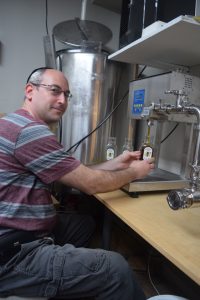
It seems as if it wasn’t all that long ago that Rosh Hashanah honey came in two basic varieties. Golden Blossom was sold in the jar with its iconic green and gold label, and store brand honey bore the name of whatever establishment you happened to be patronizing at that particular point in time. As time went on, honey started showing up in those cute little plastic bear squeeze jars and in bottles bearing the names of just about every major kosher food company. But today, honey is most definitely having a moment. On a trip to our local kosher supermarket two weeks before Rosh Hashanah I was greeted by a massive honey display. There was honey in shades ranging from gold to nearly black and even blue. There was honey packed in skinny straws, gift sets and decorative bottles. There was raw honey still in the comb and honey in flavors like raspberry, mesquite, and avocado. I’ll tell you one thing – this definitely wasn’t the honey of my childhood – which now that I think about it, is perfectly fine with me.
It goes without saying that a discussion about honey is going to have to include some talk about bees, although it seems fair to say that most of us have made it a habit to avoid those buzzing, winged creatures. Although honeybees do us a tremendous service, providing the honey that graces Rosh Hashanah tables far and wide while also pollinating more than a few varieties of fruit and nuts, they do come with those pesky, pointy stingers, which led me to believe that any rational human being would do their best to avoid bees. That assumption proved to be wrong, however, when I spoke to two completely sane individuals who spend considerable amounts of their spare time not only working with bees, but also protecting them in order to reverse a trend that has the honeybee population dwindling rapidly each year.
Rabbi Daniel Senter is the chief operating officer of Kof-K Kosher whose hobbies run the gamut. A magician and an EMT who is certified as both a mohel and a shochet, he also enjoys restoring cars, brewing beer, foraging, and homesteading. According to Rabbi Senter’s official bio, he lives in both Teaneck and Woodridge, New York with “his wife, five children, four goats, a dozen chickens, and a few million bees.”
Rabbi Senter’s fascination with bees began approximately eight years ago when a friend who had a farm in upstate Dutchess County needed some help with a mobile chicken coop. Paying a visit in order to lend a hand, Rabbi Senter noticed a stack of wooden boxes and a chain link fence. Swarms of bees were flying in and out of the boxes and over the fence.
“I asked him what it all was and he told me ‘those are my bees,’” recalled Rabbi Senter. “I told him he was crazy and then asked what the fence was for. That one, he told me, was to keep the bears away.”
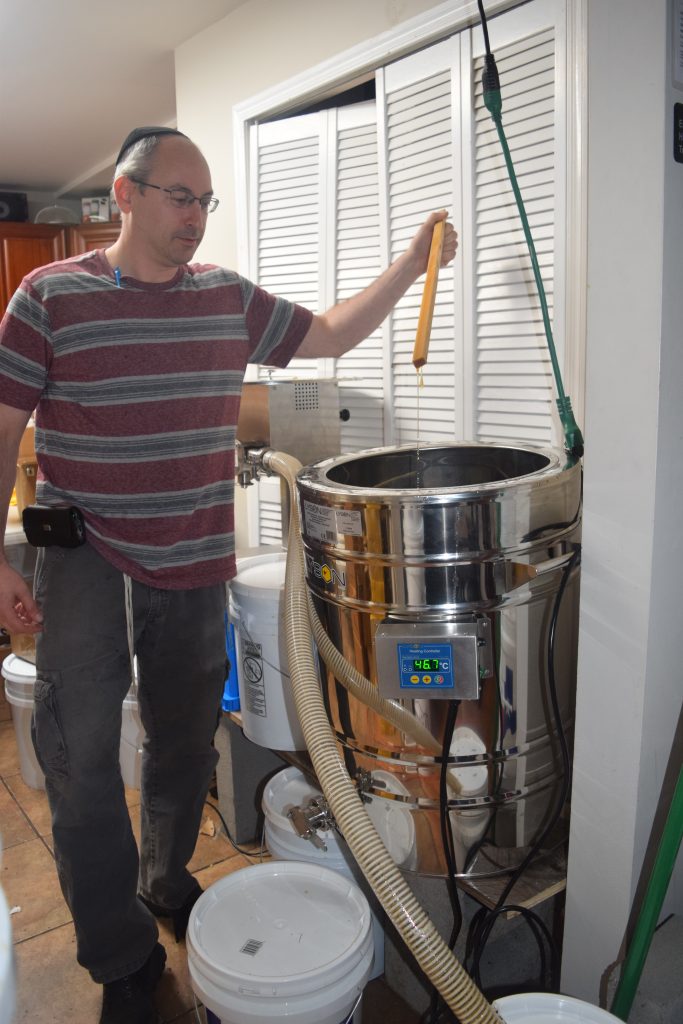
The sight was so intriguing that Rabbi Senter found himself taking on yet another project, and he started researching bees, buying his first hive the following spring. Today, he has more than 100 hives in various locations in upstate New York, Manhattan, and New Jersey. And in what can only be described as the ultimate irony, Rabbi Senter discovered the hard way that he was allergic to bee stings. His reaction is thankfully, not life threatening, but still fairly extreme.
“I blew up like a balloon and my kids told me I look like the Michelin Man,” said Rabbi Senter.
Unwilling to give up on his honeybees, Rabbi Senter takes monthly allergy shots and he goes out of his way to be ultra-cautious as he tends to his hives. While the average person might find the thought of thousands of bees unnerving, Rabbi Senter finds interacting with bees to be extremely relaxing. He even teaches beekeeping to high schoolers.
“We suit up and the kids are away from any technology,” explained Rabbi Senter. “There are no cell phones and no texting and after our 45 minutes, not a single kid in the group can tell you what time it is. They get lost in what they are doing. It’s back to the basics; just you and the bees.”
Approximately 80 pounds of honey have to remain in the hive over the winter for bees to survive in our area, but the remainder is available for harvesting. Rabbi Senter estimated that he has already gotten 2,000 pounds of honey this year, with at least another thousand still waiting to be collected from his hives. Over the years, Rabbi Senter has sold his honey at the Teaneck farmer’s market and through direct sales, and he has also filled orders for schools and institutions who use it for pre-Rosh Hashanha gifts and fundraisers. Rabbi Senter saves a portion of his honey harvest for people with allergies who find the pollens that are present in local honey help them build up their immunity to those allergens that are in the air.
Having always assumed that honey was produced from pollens on low-lying plants like clover and alfalfa, I was surprised to learn that it can also be derived from flowering trees. Rabbi Senter’s favorite honey is a late spring variety with a mild flavor that comes from the flowers of the black locust tree, with apple, basswood, and Japanese knotwood proving to be good sources of honey as well. Always happy to share his passion of bees with others, Rabbi Senter has mentored other would be beekeepers including Monsey resident Zev Oster who, over the past four years, has worked his way up to approximately 100 hives, scattered throughout Rockland County. Like Rabbi Senter, Oster is all in when it comes to bees and honey – the license plate on his SUV reads “ILUVBEES” and a decorative beehive dangles from his mailbox.
Oster harvested his first honey in 2016, walking away with 30 pounds of the sweet stuff. Having acquired many more hives over the years, also a certain percentage are lost every winter, Oster was rewarded this year with 2,700 pounds of honey. All of it was extracted from the hives from May to mid-July, an effort that involved blood, sweat and tears.
“It was a tremendous amount of work and I got up at 6:30 in the morning before it got too hot,” said Oster. “By 9:30 or ten o’clock it just wasn’t possible to work out there anymore most days because of the heat and I went back out after work, staying out until 9 P.M. checking on the hives.”
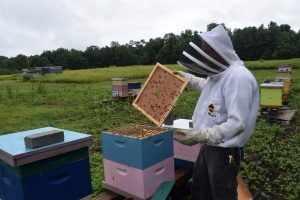
Oster bottles his product under the Rockland Honey label, topping each bottle with a beeswax seal from his hives, often staying up until 3 A.M. bottling honey during the busy season. The honey he harvests is labeled simply as local honey, without no particular variety specified, because there is no way to know exactly what plants the bees are getting their pollen from.
“If you have hives in an area that is surrounded by nothing but acres and acres of blueberries, then you know that it is blueberry honey, but here we can’t say for sure exactly what kind of honey our bees are producing,” explained Oster, who is also experimenting with honey made from goldenrod which flowers in September, further extending the honey season.
In addition to its Monsey-area honey, Rockland Honey sells a wide variety of products brought in from other honey producers throughout the United States. Oster’s products are available online and in stores in Monsey and beyond and include more than ten flavors of pure raw honey and honey sticks in fruity, floral, sour and exotic flavors such as watermelon, pink lemonade, pina colada and chocolate. Like Rabbi Senter, Oster’s favorite honey flavor is also derived from the pollen of a tree I have never even heard of – tulip poplar.
While many Jewish families have small kitchens in their basements that are designated for Pesach preparations, the Oster’s downstairs kitchen is used exclusively for honey. This year’s bountiful harvest has had Oster tweaking his operations, moving his extraction equipment into the garage, while the bottling remains in the basement, a change that meant that Oster had to move hives that had previously been in his backyard to another location.
“Once we were spinning the honey in the garage, we couldn’t keep the bees in the backyard anymore,” said Oster. “In ten minutes, we could have had hundreds of thousands of bees in the garage, which would have been a big problem.”
Some of Oster’s hives are quite a sight to see, housed in colorfully painted boxes that are anything but typical. There is one painted to look like a police station, another done in a Kosel motif, and in a Trumpian reference, one bearing the words “Make America Sweet Again.” I took advantage of an opportunity to see them up close, maybe a little closer than I might have liked, after taking Oster up on an invitation to see the bees, donning a bee jacket, complete with an attached hood and veil that covered my entire face. It definitely wasn’t one of my finest fashion moments and thankfully there are no pictures to document that particular episode of my career as a writer.
We take it for granted that there will always be honey on our Rosh Hashanah tables, but honeybees have been mysteriously dying out for quite a while. According to Newsday, 80 to 90 percent of the honeybees in central Maryland died from the summer of 2017 to the spring of 2018 and a report that appeared in Business Insider estimated that 10 million of the 83 million of the world’s beehives were lost in the year 2014 alone.
The jury is still out on the reasons for those losses, which affect not only honey production but other items pollinated by bees including apples, peaches, plums, nectarines, strawberries, and almonds.
“The plight of the honeybee is very concerning,” said Rabbi Senter. “They are disappearing in record numbers and it could be due to a number of factors including loss of habitat, a parasite called the Varroa mite, or pesticides.”
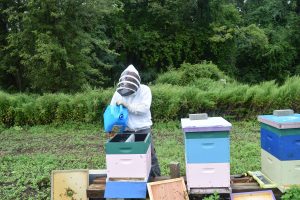
Thankfully, interest in beekeeping has been growing steadily and Oster is just one bee enthusiast who took up the hobby after hearing the honeybee population was declining, doing his part to bolster the honeybee population. In addition to expanding his hives every year, Oster founded the Rockland Bee Club several years ago, with 15 to 20 people turning out at every monthly meeting. Several parties have reached out to Oster and offered to let him put hives on their land, including the mayor of Haverstraw, a town located northwest of Monsey.
“It’s good publicity,” remarked Oster who has hives on a ramp to a heavily traveled local roadway. “People beep and they stop and get out of their cars and ask questions. They are really fascinated by it.”
Rabbi Senter notes that while honeybees may be in trouble, it’s not all doom and gloom for our little winged friends. Scientists have been working hard to solve the mystery of what is known as colony collapse disorder, with Israel leading the pack on pioneering research in the field. Citing a five-tiered approach that includes improving honeybee health and nutrition, preserving and restoring their environment, combatting disease, eliminating harmful pesticides and promoting awareness, Rabbi Senter expressed his hope that we will be able to enjoy our apples in dipped in honey for many years to come.
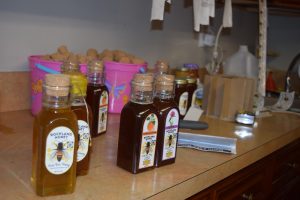
What kind of honey will grace your Rosh Hashanah table this year? It seems like this year there are more flavors to choose from than ever before. As for me, I’ll be polishing up my honey dish and pulling out a jar of vanilla creamed honey that I got as a gift. And of course, there is going to have be a plastic honey bear somewhere on my table at some point in time over the Yom Tov season. Some traditions are just too sacred to tamper with.
Sandy Eller is a freelance writer who writes for numerous websites, newspapers, magazines and many private clients. She can be contacted at sandyeller1@gmail.com.
You must be logged in to post a comment.